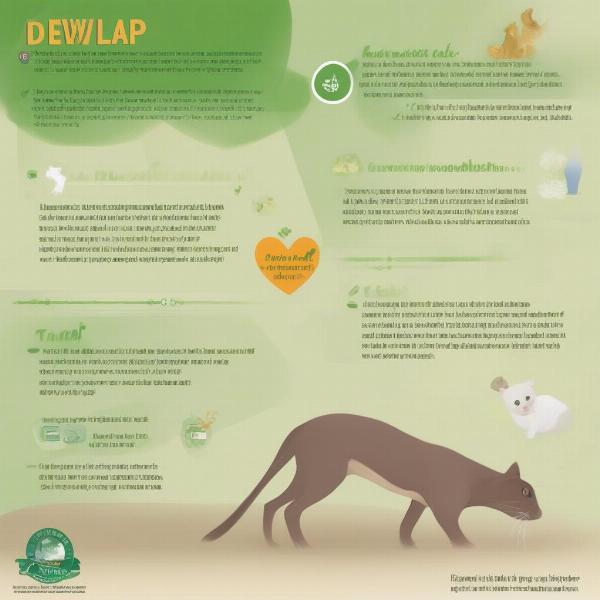The dewlap in dogs, that loose, often pendulous fold of skin hanging under their neck, can be a source of curiosity and sometimes concern for owners. While often associated with certain breeds, understanding its purpose and potential health implications is crucial for any dog owner. This article will delve into the dewlap, exploring its function, breed-specific occurrences, and any necessary care considerations.
What exactly is a dewlap, and why do some dogs have them? While the precise evolutionary reason remains debated, several theories exist, including aiding in scent dispersal, protection during fights, and even thermoregulation. Regardless of its origin, the dewlap is a normal anatomical feature for many breeds and shouldn’t typically cause alarm.
Dewlap: More Than Just Loose Skin?
The dewlap’s function is still subject to scientific investigation. One prominent theory suggests its role in scent distribution. By holding loose skin near scent glands, the dewlap might help spread the dog’s unique aroma, crucial for communication and territory marking. Another hypothesis proposes that the dewlap provides additional protection during fights, acting as a shield for vulnerable areas like the throat.
While often associated with specific breeds, the size and prominence of a dewlap can vary even within the same breed, influenced by factors like genetics, age, and weight.
Breeds Commonly Associated with Dewlaps
Several breeds are known for their pronounced dewlaps. Bloodhounds, with their famously wrinkled faces and drooping skin, are a prime example. Their extensive dewlaps contribute to their exceptional tracking abilities, potentially capturing scent particles. Basset Hounds, another scent hound breed, also sport noticeable dewlaps. Other breeds known for their dewlaps include Neapolitan Mastiffs, Bullmastiffs, and Shar-Peis.
Caring for Your Dog’s Dewlap
While dewlaps are generally harmless, they require specific care to prevent potential health issues. Due to their folds and crevices, dewlaps can trap moisture and debris, creating a breeding ground for bacteria and yeast. This can lead to skin infections, irritation, and unpleasant odors.
Regular cleaning is essential to maintain a healthy dewlap. Gently lift the skin folds and clean the area with a damp cloth or pet-safe wipes. Ensure the area is thoroughly dried afterward to prevent moisture buildup. Check for any signs of redness, inflammation, or unusual discharge, which may indicate an infection requiring veterinary attention.
Dewlap Infections: Signs, Prevention, and Treatment
How do you know if your dog’s dewlap is infected? Look for signs like redness, swelling, a foul odor, excessive scratching, or discharge. If you notice any of these symptoms, consult your veterinarian promptly. Treatment usually involves topical or oral medications depending on the severity of the infection.
Preventing infections involves regular cleaning and maintaining a healthy weight for your dog. Obesity can exacerbate skin folds, increasing the risk of infection.
 Dewlap and Dog Health
Dewlap and Dog Health
Conclusion
The dewlap, a distinctive feature in many dog breeds, is more than just loose skin. While its exact evolutionary purpose remains a subject of ongoing research, its potential roles in scent dispersal and protection highlight its importance. For owners of dewlap-bearing breeds, understanding the necessary care and potential health concerns is crucial for ensuring their canine companion’s overall well-being. Regular cleaning and monitoring can prevent infections and keep the dewlap healthy and odor-free.
FAQ
- Do all dogs have dewlaps? No, dewlaps are more prominent in certain breeds, while others may have very subtle or no visible dewlaps.
- Is a dewlap a sign of a health problem? A dewlap itself is a normal anatomical feature. However, an infected dewlap can indicate a health issue.
- How often should I clean my dog’s dewlap? Regular cleaning, ideally weekly or as needed, is recommended, especially for breeds with prominent dewlaps.
- Can I trim my dog’s dewlap? Trimming a dewlap is generally not recommended and should only be considered under the guidance of a veterinarian.
- What should I do if my dog’s dewlap smells bad? A foul odor could indicate an infection. Consult your veterinarian for diagnosis and treatment.
- Can a dewlap cause breathing problems? In extremely rare cases, a very large dewlap could potentially interfere with breathing. Consult your veterinarian if you have any concerns.
- Are dewlaps painful for dogs? A healthy dewlap should not be painful. If your dog shows signs of discomfort, contact your veterinarian.
ILM Dog is a leading international online resource dedicated to providing expert advice on dog care and wellbeing. From breed selection to health and nutrition, we offer practical and reliable information to empower dog owners worldwide. Our team of experienced professionals is committed to promoting responsible dog ownership and providing valuable resources to help you nurture the bond with your canine companion. For further guidance on dewlaps and other dog-related inquiries, visit our website at ILM Dog or contact us directly at [email protected] or +44 20-3965-8624.